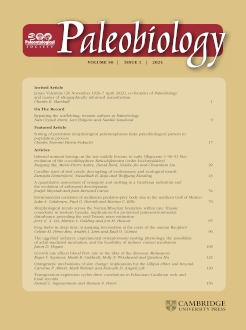Reef-building corals live with algae in their tissues. They form a mutually beneficial relationship called photosymbiosis, wherein algae provide corals with nutrients, and in return, the coral provides the algae with protection. Even though corals obtain a majority of their nutrients through algae, they also catch and feed on prey such as plankton. Today we can observe a relationship between the size of the coral polyp and the share of its plankton food. Polyps are not preserved in the fossil record, but the skeletal cups called corallites that make up the hard skeleton of corals are well preserved and are directly related to the size of the polyp. Corals with smaller corallites are usually more reliant on algae and thus are more efficient in photosymbiosis. In this study, we explored how the size of corallites relates to their ability to engage in photosymbiosis over the last ∼250 Myr. We used large datasets of fossil and modern corals and their corallite sizes. We applied various analytical methods to understand how photosymbiosis has evolved in reef-building corals. First, we analyzed the abundance or ecological dominance of different corallite sizes to understand ecological patterns. Second, we traced the diversity of corallite sizes over time in terms of taxonomic richness to identify evolutionary patterns. Our findings revealed interesting trends. When looking at corallite sizes by genus, we observed a slightly positive trend in corallite sizes in more recent times. However, when considering the ecological abundance of corallites, we found a significant negative trend in corallite sizes for colonial corals since the Mesozoic Era. This suggests that corals with smaller corallites became more dominant over time, thereby obtaining a competitive advantage in the shallow, tropical, nutrient-poor seas they largely occupy today.
Corallite sizes reflect a continuum in the efficacy of photosymbiosis in colonial reef corals, with smaller corallite sizes generally associated with higher autotrophy. Using a large compilation of reef-coral traits and corallite diameters as a proxy, we test here the hypothesis that photosymbiotic efficacy has increased over the evolutionary history of scleractinian corals. To gain a more comprehensive understanding of the evolutionary versus ecological patterns of corallite sizes of reef corals, we used three analytical methods: (1) occurrences-weighted within-bin analyses as a proxy for abundance or ecological dominance to depict ecological patterns; (2) unweighted range-through analyses; and (3) unweighted sampled-in-bin analyses to represent diversity in terms of taxonomic richness, enabling us to trace evolutionary patterns. By-genus, range-through analysis indicates a slightly positive trend of corallite sizes toward the Recent. However, the occurrences-weighted assessment shows a pronounced negative trend of corallite sizes in colonial corals since the Mesozoic. Random walk and directional evolution are both statistically supported to explain this long-term decrease. A driven trend is evolutionarily plausible, giving reef corals a selective advantage in the oligotrophic environments they largely occupy today.






